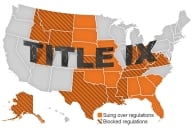You have /5 articles left.
Sign up for a free account or log in.
FAIRFAX, Va. -- A much-expanded Post-9/11 GI Bill is, as of Saturday, newly law in the land. President Obama marked the milestone in a celebratory ceremony at George Mason University Monday.
“This is not simply a debt that we are repaying to the remarkable men and women who have served -- it is an investment in our own country," Obama said. "The first GI Bill paid for itself many times over through the increased revenue that came from a generation of men and women who received the skills and education that they needed to create their own wealth. The veterans who are here today -- like the young post-9/11 veterans around the country -- can lead the way to a lasting economic recovery and become the glue that holds our communities together. They, too, can become the backbone of a growing American middle class.
“And even as we help our veterans learn the skills they need to succeed, I know that all of us can learn something from the men and women who serve our country. We have lived through an age when many people and institutions have acted irresponsibly -- when service often took a backseat to short-term profits; when hard choices were put aside for somebody else, for some other time. It's a time when easy distractions became the norm, and the trivial has been taken too seriously. The men and women who have served since 9/11 tell us a different story. While so many were reaching for the quick buck, they were heading out on patrol…. And now, with this policy, we are making it clear that the United States of America must reward responsibility, and not irresponsibility.”
And a generous reward it is. The new GI Bill provides for eligible veterans’ tuition and fees, with the maximum benefit pegged to the highest undergraduate, resident tuition rate in a given state, plus a monthly housing allowance and an annual $1,000 stipend for books. In addition, more than 1,100 colleges are participating in the Yellow Ribbon program, which stretches the tuition benefit at private colleges, in particular, by allowing colleges to enter into a matching program with the U.S. Department of Veterans Affairs to cover any difference between the maximum benefit and total tuition and fees assessed. In another important departure from past policy, and in a bid to increase retention in the Armed Forces, the new bill allows for transfer of benefits to spouses and children when those who have served six years commit to another four.
The primary champion and lead sponsor of the new GI Bill, Sen. Jim Webb (D-Va.), spoke at Monday’s ceremony, as did former Sen. John Warner (R-Va.), who advocated for inclusion of the Yellow Ribbon program. VA Secretary Eric K. Shinseki estimated Monday that about a quarter of a million veterans will benefit from the newly expanded GI Bill by 2011.
As of now, the Monday morning celebration over, attention will shift back to the administration of the program and how quickly and efficiently those checks get in the mail. Fall semesters, after all, will soon be starting. Receiving GI Bill benefits under the new program is a two-step process: First, veterans must attain certificates of eligibility from the VA, and, second, a college must certify a veteran's enrollment in order for the benefits to start flowing. Tuition benefits are paid directly to the college, and housing and book benefits directly to the veteran.
So far, the VA has received about 140,000 applications for certificates of eligibility and has processed about 112,000 of them, according to a VA spokesman, Steve Westerfeld. Not everyone who’s signed up for a certificate of eligibility plans to enroll in college this fall, however; eligible veterans have 15 years after their last period of active duty to use the benefits. In terms of veterans whose colleges have so far certified them as attending this fall, the VA has received more than 5,000 enrollment claims “and counting," Westerfeld said. The VA anticipates the number of claims will grow substantially throughout August and September, peak times for enrollment.








